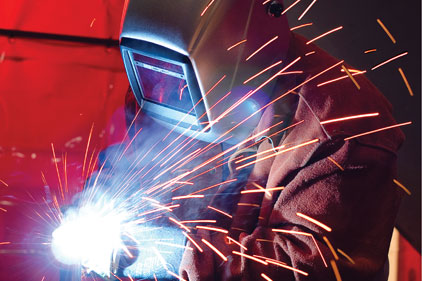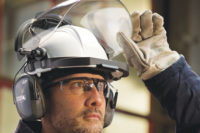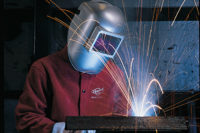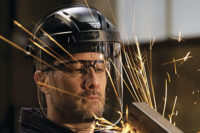Hazards commonly encountered by those performing welding operations include exposure to very hot materials, intense radiation, high noise levels and heavy falling objects. Protecting welders from head to toe is crucial to avoiding injuries such as second- and third-degree burns, hearing loss, and eye and foot injuries. This article looks at three commonly overlooked aspects of welding safety that, once considered, can enhance the safety, comfort and productivity of the workforce.
Eye and face protection
The U.S. Bureau of Labor Statistics reported 1,790 eye injuries among welders, cutters, solderers and brazers in 2008, making this occupation group the second highest overall to experience eye injuries.
Welder’s flash, a common condition caused by exposure to intense ultraviolet radiation, can result in temporary blindness as well as extreme discomfort to the eyes. More severe welding-related eye injuries result in permanent blindness.
Welding helmets are the first defense in protecting workers’ eyes from the arc. The helmet’s filter lens shades the eyes at a level that corresponds to that of the arc radiation generated by the application. There are two main types of welding helmets: those with passive lenses and those with auto-darkening filter (ADF) lenses. Passive helmets feature a fixed shade glass or polycarbonate lens that the welder looks through to conduct work. Because the filter is usually very dark, the welder must raise or remove the helmet to gain the visual acuity required to prepare the weld and then nod the helmet back into place before welding begins.
In helmets with ADF lenses, the filter lens automatically switches from a light state to a dark state in response to a change in light intensity. When the welding arc is struck, the lens instantly darkens to filter out harmful light, and when not activated, the lens is light enough to see through easily. Because it may be left in place for the duration of work, the ADF lens enables greater safety, productivity and higher quality welds. It also eliminates neck injuries commonly experienced by those wearing passive lenses, who must repeatedly nod their lens into place.
In addition to providing ample shade to the eyes, welding helmets serve to shield the eyes and face from intense infrared radiation, flying debris, weld spatter and slag, and sparks and flame. They are durable and may provide ample protection against basic hazards for many years. However, workers who rely on outdated welding helmets are at a significant disadvantage when it comes to overall performance. Recent advances such as lighter weight materials and sleek designs reduce weight and bulk, while innovations in comfort and fit significantly reduce fatigue and soreness. In many applications, welding helmets are worn in combination with other types of PPE. When this is the case, look for new designs that ensure excellent stability and easy interaction with hard hats, hearing protection and respiratory protection.
Hearing protection
Noise hazards are common among welding applications. Since prolonged exposure can lead to hearing loss, OSHA’s noise standard, 29 CFR 1910.95, requires the use of hearing protection when the employee’s noise exposure exceeds an 8-hour time-weighted average sound level of 90 dBA. It is important to monitor noise hazards and to provide hearing protection where needed. Options abound, and today’s hearing protection is more effective, convenient and comfortable than ever before.
Since they are small and do not interfere with other PPE, ear plugs work in many applications. Recent advances — such as new materials and comfort and fit features — allow ear plugs to feel significantly more comfortable, provide higher levels of hearing protection and exert less pressure in the ear canal than older foam models. Like other forms of PPE, the more comfortable the ear plug, the longer workers will wear them. When selecting ear plugs, look for new models made with advanced materials that offer the highest level of comfort as well as noise protection.
When welding work is conducted out-of-position or overhead, low-profile ear muffs are a versatile solution. Not only does the narrower cuff of this style fit comfortably when worn under the welding helmet, but because ear muffs cover the ear, they also keep sparks or spatter from jumping into the ear canal.
Foot protection
Protecting the feet is an often overlooked aspect of welders’ PPE. Yet, hazards ranging from fire, heat and sparks to falling objects and slippery surfaces are all common in welding areas. Advanced technologies in protective footwear ensure that workers are better protected — and more comfortable — than ever before.
Welders in extreme environments should be outfitted with footwear featuring flame-retardant leather, abrasion- and heat-resistant stitching, protective metatarsal shields and heavy-duty rubber outsoles that are heat resistant to the highest possible temperature. For applications where work floors are greasy, wet or slippery, it is important to look for styles with anti-slip soles to help workers avoid falls. In environments where there is risk of falling objects, be sure to select boots with a steel toe or protective toe cap. A recent no-lace design allows for slip-on convenience while eliminating the risk of burn-through in laces.
Finally, because many workers spend the majority of their shift standing up, comfort is a key aspect to consider. Look for footwear that features ergonomic design, improved cushioning technologies, wider toe boxes and lightweight footbeds to support employees’ overall comfort and productivity.
No matter how frequently — or infrequently — welding operations are performed, it is important to provide workers with the proper PPE to keep them safe. Each year, assess the welding PPE in use and determine whether your workforce is outfitted in the safest, most effective equipment. By understanding the advantages offered by the latest innovations, you can make selections that not only support workers’ protection but also their comfort. Since comfortable PPE is PPE that workers are more likely to wear, this approach supports employers’ goals in creating an effective overall culture of safety.







